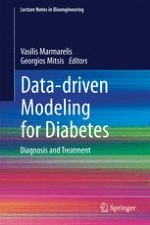2014 | OriginalPaper | Buchkapitel
Nonlinear Modeling of the Dynamic Effects of Free Fatty Acids on Insulin Sensitivity
verfasst von : Vasilis Z. Marmarelis, Dae C. Shin, Georgios D. Mitsis
Erschienen in: Data-driven Modeling for Diabetes
Verlag: Springer Berlin Heidelberg
Aktivieren Sie unsere intelligente Suche, um passende Fachinhalte oder Patente zu finden.
Wählen Sie Textabschnitte aus um mit Künstlicher Intelligenz passenden Patente zu finden. powered by
Markieren Sie Textabschnitte, um KI-gestützt weitere passende Inhalte zu finden. powered by
